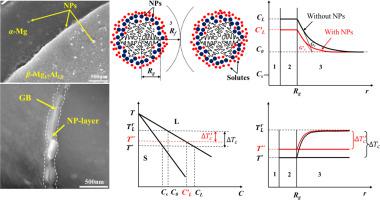当前位置:
X-MOL 学术
›
Mater. Des.
›
论文详情
Our official English website, www.x-mol.net, welcomes your feedback! (Note: you will need to create a separate account there.)
Nanoparticle-induced growth behavior of primary α-mg in AZ91 alloys
Materials & Design ( IF 8.4 ) Pub Date : 2020-11-01 , DOI: 10.1016/j.matdes.2020.109146 Haonan Li , Kui Wang , Gaopeng Xu , Haiyan Jiang , Qudong Wang , Wenjiang Ding
Materials & Design ( IF 8.4 ) Pub Date : 2020-11-01 , DOI: 10.1016/j.matdes.2020.109146 Haonan Li , Kui Wang , Gaopeng Xu , Haiyan Jiang , Qudong Wang , Wenjiang Ding

|
Abstract Significant grain refinement of AZ91 alloys was achieved by ceramic nanoparticle(NP)-induced growth control. Advanced characterization techniques including 3D tomography and in-situ observation were carried out to examine the microstructure evolution. The results show that the NPs are distributed in matrix in three ways, i.e. along the grain boundaries, inside the α-Mg grains and within the interior of β phases. The intergranular NPs that are distributed along the grain boundaries can form a multilayer of NPs covering the surface of α-Mg, greatly restricting the grain growth. A numerical model is proposed to predict the grain size, in which the solute concentration gradient at dendrite tip and the impingement of grains are recognized as two pivotal factors in modelling. It is demonstrated from the model prediction that a reduced growing rate of α-Mg can be obtained upon NP addition due to the lowered solute concentration gradient at dendrite tip, which could increase the nucleation events, accelerate the grain impingement and thus induce significant grain refinement. Given the chemically and thermally stability of ceramic NPs, which can avoid the intrinsic drawbacks of conventional inoculation, e.g. element poisoning, NP-induced growth control (NIGC) may provide a new avenue for grain refinement in magnesium alloys.
中文翻译:

AZ91合金中初级α-mg的纳米粒子诱导生长行为
摘要 通过陶瓷纳米颗粒(NP)诱导生长控制实现了AZ91合金的显着晶粒细化。进行了包括 3D 断层扫描和原位观察在内的高级表征技术来检查微观结构的演变。结果表明,纳米颗粒以三种方式分布在基体中,即沿晶界、α-Mg晶粒内部和β相内部。沿晶界分布的晶间纳米颗粒可以形成多层纳米颗粒覆盖在 α-Mg 表面,极大地限制了晶粒的生长。提出了一个数值模型来预测晶粒尺寸,其中枝晶尖端的溶质浓度梯度和晶粒的碰撞被认为是建模中的两个关键因素。模型预测表明,由于枝晶尖端溶质浓度梯度降低,添加纳米颗粒可以降低 α-Mg 的生长速率,这会增加成核事件,加速晶粒碰撞,从而导致显着的晶粒细化. 鉴于陶瓷纳米颗粒的化学和热稳定性,可以避免传统接种的固有缺陷,例如元素中毒,纳米颗粒诱导生长控制 (NIGC) 可为镁合金的晶粒细化提供新的途径。
更新日期:2020-11-01
中文翻译:

AZ91合金中初级α-mg的纳米粒子诱导生长行为
摘要 通过陶瓷纳米颗粒(NP)诱导生长控制实现了AZ91合金的显着晶粒细化。进行了包括 3D 断层扫描和原位观察在内的高级表征技术来检查微观结构的演变。结果表明,纳米颗粒以三种方式分布在基体中,即沿晶界、α-Mg晶粒内部和β相内部。沿晶界分布的晶间纳米颗粒可以形成多层纳米颗粒覆盖在 α-Mg 表面,极大地限制了晶粒的生长。提出了一个数值模型来预测晶粒尺寸,其中枝晶尖端的溶质浓度梯度和晶粒的碰撞被认为是建模中的两个关键因素。模型预测表明,由于枝晶尖端溶质浓度梯度降低,添加纳米颗粒可以降低 α-Mg 的生长速率,这会增加成核事件,加速晶粒碰撞,从而导致显着的晶粒细化. 鉴于陶瓷纳米颗粒的化学和热稳定性,可以避免传统接种的固有缺陷,例如元素中毒,纳米颗粒诱导生长控制 (NIGC) 可为镁合金的晶粒细化提供新的途径。


























 京公网安备 11010802027423号
京公网安备 11010802027423号